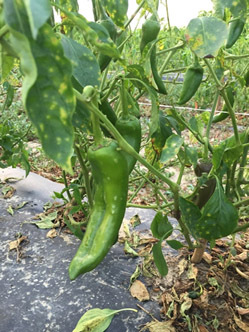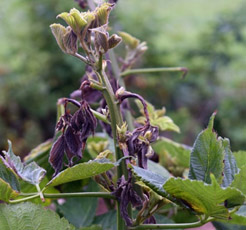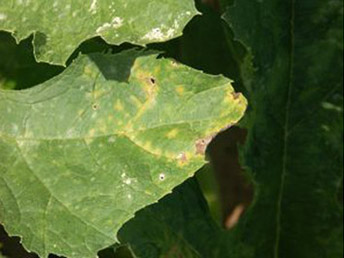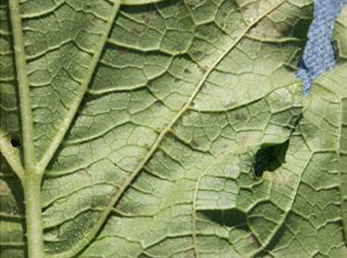Address any questions or comments regarding this newsletter to the individual authors listed after each article or to its editors, Nathan Johanning, 618-939-3434, njohann@illinois.edu or Bronwyn Aly 618-695-6060, baly@illinois.edu. The Illinois Fruit and Vegetable News is available on the web at: http://ipm.illinois.edu/ifvn/. To receive or be removed from email notification of new postings of this newsletter, contact Nathan Johanning or Bronwyn Aly at the phone numbers or email addresses above.
In This Issue:
Upcoming Programs (listings for beginning and established growers)
Regional Reports (north-central, southern Illinois)
Vegetable Production and Pest Management (Pumpkin Disease Management, Remain Diligent on Pest Monitoring)
Fruit Production and Pest Management (Broadmite in Blackberries)
Record-Keeping (Record-Keeping in Your Pocket with Google Drive)
Upcoming Programs
Check the Illinois SARE calendar for a full list of programs and links for registration.
http://illinoissare.org/ and http://illinoissare.org/calendar.php
Also see the University of Illinois Extension Local Food Systems and Small Farms Team's website at:
http://web.extension.illinois.edu/smallfarm/ and the calendar of events at http://web.extension.illinois.edu/units/calendar.cfm?UnitID=629.
- USDA- ARS Webinar: Specialty Crops Market News --Capturing the Universe. Thursday, July 14, 2016 2:00 p.m. Eastern time (3:00 p.m. Central). This Webinar will be discussing some of the online resources the USDA-ARS has available through the Specialty Crops Market News Website. For more information or to register for this webinar click here.
- Good Agricultural Practices (GAPs) Webinar Series, Tuesdays: July 26 – August 16, 2016 from 6:00 p.m. - 8:00 p.m. This Webinar Series Has Been Cancelled
- Summertime Lunch and Learn Webinar Series. Illinois Farmers Market Association will be offering a series of free midday Monday webinars (12-1 PM) for market managers, producers and others. These brownbag learning opportunities will cover a variety of topics pertinent to the 2016 market season. Pre-registration is required. Sign up now at: https://web.extension.illinois.edu/registration/?RegistrationID=14799.
- July 25 – Local Flavors: From Farmers Market to Restaurant Table
- Aug 1 – Green City??
- Aug 8 – Creating a Market Cookbook
- Southern Illinois Summer Twilight Series, 4 Monthly On-Farm Meetings on Mondays, May through August, 6:00 p.m. For more information or details, contact Bronwyn Aly at 618-382-2662; baly@illinois.edu or Nathan Johanning at 618-687-1727; njohann@illinois.edu Save the dates, more details to follow:
- Aug 8 – Grant's Orchard, near Johnston City, IL
- Illinois Pumpkin Field Day, Wednesday, August 31, 2016, 10 a.m. Ewing Demonstration Center, 16132 N. Ewing Rd; Ewing, IL 62836. For more information, contact Nathan Johanning at 618-687-1727 or njohann@illinois.edu
- 7th National Small Farm Conference - Creating and Sustaining Small Farmers and Ranchers, September 20-22, 2016. Virginia Beach Convention Center, Virginia Beach, VA. For more information, call 804-524-5626 or email NSFC2016@vsu.edu
- Meet the Farmers, Meet the Buyer. Monday, October 10, 2016 10:00 AM to 5:00 PM (Doors open at 9:30 AM). St. Louis University campus in the II Monastero Building, 3050 Olive Street, St. Louis, Missouri This event is an opportunity for farmers to meet with buyers and learn what it takes to do business with the grocery and foodservice industries. To register visit http://www.ilfb.org/ifb-news-and-events/conferences-events/october-10,-2016-meet-the-buyer-event.aspx. For more information contact Cynthia Haskins, 309-557-2155; CHaskins@ilfb.org.
- Anyone interested or needing a copy of the 2016 Midwest Fruit Pest Management Guide can contact Laurie George, ljgeorge@illinois.edu at the Jefferson Co. Extension Office 618-242-0780. Plenty of copies are available!
Regional Reports
From north-central Illinois... Recent rains have given outdoor crops a much needed drink. From July 1st to 18th, Monmouth reported 5.3 inches of rain. My outdoor tomatoes are still showing signs of our hot, dry June. Physiological leaf roll showed up a few weeks ago. At first glance I was alarmed that my plants were subjected to herbicide drift, however, looking around I noticed several other tomatoes were growing perfectly fine. Those tomato plants showing symptoms are in a more exposed location in very well-drained soil. Another possible cause can be a result of pruning tomatoes during dry periods. And of course, I pruned all my tomatoes during our "drought" in June. According to Extension articles, different tomato cultivars appear more susceptible than others, regardless, leaf roll does not diminish yields. My plants have already begun to grow out of it and are setting fruit as expected. More information on Physiological Leaf Roll.
A grower recently reported severe thrips damage to their onion, shallot and garlic crops this year. A reminder that crop rotation is the best practice to address this pest.
Seems like everything is early this year and our garlic was no exception. Garlic was pulled and is currently curing in the machine shed. There were a few scapes I missed that set flower. From a market standpoint, the bulbs were much smaller. I will be planting those this fall.
Chris Enroth (309-837-3939; cenroth@illinois.edu)
From southern Illinois ... We are in the midst of the heat and humidity of southern Illinois summers. This week temperatures are starting in the 90s for highs and the last half of the week highs are predicted to be in the low 100s. Right after the last issue of the newsletter went out after the 4th of July, we got quite a bit of rain here in southern Illinois. In Murphysboro, we received 4 inches of rain on 7/6 alone and overall for that week we had around 7". Rainfall was generally less as you headed north from here and more as you headed south. I hear totals from the week ranged from 9-14 inches. As you can imagine this heat and moisture has been ideal for our plant diseases and it seems that tomatoes and also peppers have struggled because of this. I have seen multiple cases of bacterial canker on tomatoes and some root rots on peppers. Also early blight/bacterial spot has been showing up especially on early tomato plantings. Remember that a preventative spray schedule is important in disease management for many of our fungal and bacterial diseases. Also, for any of our soil borne diseases crop rotation and also any kind of mulch (plastic, organic, etc.) to help minimize rain splash of soil particles will also help to slow the onset of disease.
Out in the field we are now into the main season for peaches with many freestone varieties coming in. A wide range of fruits and vegetable is out on the market. At home, my late blueberries are coming to an end with just a few more left on some of the latest varieties. Pumpkins transplants are really taking off now and off. Sidedress applications of nitrogen will be just around the corner for the pumpkins and a postemergence herbicide application for grass control as well. I have heard a few good reports from growers that have used Reflex PRE on pumpkins this year. If you have used Reflex on your pumpkins and would like to share any report regarding weed control or crop injury, good or bad from your experience, please drop me a line.
Nathan Johanning (618-939-3434; njohann@illinois.edu)
Vegetable Production and Pest Management
Pumpkin Disease Management Steps
I have received several calls about pumpkins recently. This article will outline a few steps growers should think about to prevent diseases in pumpkins.
Virus diseases. There are several virus diseases that affect pumpkins in the Midwest. The most important diseases include: papaya ring spot, watermelon mosaic and zucchini yellow mosaic virus. Aphids transmit all these diseases. Many of the aphids responsible are carried up from the south each year on winds. Therefore, aphids with virus are more common later in the summer; pumpkins planted later in the season are more likely to be affected with one of the virus diseases listed above. Plant pumpkins by about June 15 to avoid having the fruit set during the period of high virus disease pressure.
Powdery mildew. It is nearly impossible to find a pumpkin vine in August without powdery mildew. However, this disease does not have to affect production. The first decision a grower should make regarding powdery mildew of pumpkin is to choose, if at all possible, a variety with partial resistance to powdery mildew. Selected varieties with partial resistance are listed in the Midwest Vegetable Production Guide <mwveguide.org>. Varieties that have partial resistance to powdery mildew may still require fungicides, however fewer fungicide applications will be required for disease control if the appropriate variety is chosen.
Fungicides should be applied for management of powdery mildew of pumpkin at about the 'bush stage' (Figure 1). The bush stage is the point where the pumpkin plant has grown up into an upright plant, shortly before vining starts. It is at this bush stage that high humidity inside the plant canopy favors powdery mildew development. (The fungus that causes powdery mildew requires high humidity, but not leaf wetness.)

Figure 1: Fungicides for management of powdery mildew
should be applied when pumpkins have reach the ‘bush’ stage as seen here.
More information about fungicides for powdery mildew of pumpkin can be found at https://vegcropshotline.org/article/powdery-mildew-of-cucurbits/. Briefly, the following fungicides have proven effective: Aprovia Top, Fontelis, Luna Experience, Inspire Super, Merivon, Quintec, Procure, Rally, Torino. It is important to alternate the FRAC groups (aka, MOA groups) to avoid getting powdery mildew fungi that are resistant to these fungicides, but also for good control. The best treatments in my trials have been those that alternated fungicides of several different FRAC groups.
Downy mildew. Although the name of this disease is similar to powdery mildew, the disease is caused by an unrelated fungus-like organism. This fungus-like organism does not survive in the Midwest and must be blown in every year. Therefore, downy mildew is not observed in most years until August or September. Downy mildew causes an angular yellow lesion on the surface of the leaves and a dark, fussy appearing growth on the underside of the leaf (Figure 2 and 3). Watch the Hotline for updates to the occurrence of this disease around the eastern U.S. Do not apply expensive downy mildew products unless this disease has been observed close-by. As of this writing, downy mildew has not been observed in Indiana this year. More information about downy mildew of pumpkin can be found in this extension publication https://www.extension.purdue.edu/extmedia/BP/BP-140-W.pdf or this video https://www.youtube.com/watch?v=sz0vZ-t0gyg.
|
|
Bacterial spot. This disease has become more important in the last several years. The bacterium that causes bacterial spot survives in crop residue and may be transmitted through seed or transplants. Crop rotations of 2 to 3 years out of cucurbits are important to manage this disease. However, many growers continue to have problems with bacterial spot even with good crop rotations. (Bacterial spot of tomato is a different disease caused by a different bacterium.)
The products I recommend for bacterial spot of pumpkin are copper mixed with a mancozeb product. Copper is a bacteriacide; mancozeb products allow more of the copper in copper based products to be available. These products should be applied 1) if the symptoms of bacterial spot are recognized on the seedling or young plant or 2) at the stage of the plant where fruit are about softball size. It is at about this stage that fruit are most susceptible to bacterial spot. As the fruit matures, the pores (known as stomates) in the surface of the fruit become blocked by a waxy type substance making the fruit less susceptible to bacterial spot.
Phytophthora blight. This disease affects many different crops including other cucurbits (See watermelon article in last Hotline issue) and solanaceous crops-especially pepper. The fungus-like organism that causes Phytophthora blight survives well in soil and spreads easily from leaf to leaf--a dangerous combination. (Yes, Phytophthora blight and downy mildew are caused by related fungus-like organisms and some of the same fungicides are effective against both.) A four-year crop rotation will help to reduce the severity of Phytophthora blight.
While Phytophthora blight of watermelon affects primarily fruit, this disease can affect fruit and vines of pumpkin plants. Thus, watermelon growers can wait until fruit set to start fungicide applications, pumpkin growers must worry about all stages of plant growth. This spring was relatively dry, therefore fungicide applications for Phytophthora blight may have been unnecessary. However, with the more recent wet weather, Phytophthora blight may become a problem. The fungus like organism that causes Phytophthora blight loves heavy rains and the pools and puddles that are left behind in poorly drained fields.
The fungicides that are effective against Phytophthora blight are the same as discussed https://vegcropshotline.org/article/phytophthora-fruit-rot-of-watermelon-2/. Also, see the Midwest Vegetable Production Guide at www.mwveguide.org.
The information above only outlines my ideas for disease management on a handful of pumpkin problems. Please contact me for more detailed information.
Dan Egel, Extension Plant Pathologist, Purdue Vegetable Crops Hotline, Purdue University (812-886-0198; egel@purdue.edu)
Remain Diligent on Pest Monitoring

Bacterial spot on peppers in
southern Illinois. Photo by B. Aly.
With all of the rain, humidity, and high temperatures of the past few weeks, conditions have been quite favorable for fungal and bacterial diseases in tomatoes and peppers. I found the following information from an article written on June 29, 2016 by Dr. Beth Gugino, Associate Professor Vegetable Pathology, Penn State, to be very informative on how copper sprays actually work as a protectant. Dr. Gugino wrote, "During the growing season, copper-based products are the primary tool used to reduce bacterial spread within and between plants. Copper is typically applied in a fixed form which lowers its solubility in water. Once applied to the plant surface, copper ions are slowly released when the plant surface becomes wet. When copper ions come in contact with a bacterial cell, they function to denature proteins thereby destroying enzymes necessary for the bacterial cell to function. Since copper is a protectant, once the bacteria enter the plant it is no longer exposed to the copper ions."
It can be hard to identify which disease is affecting your crop. The University of Kentucky has the following manual available to help when scouting for pests: ID - 172 An IPM Scouting Guide for Common Pests of Solanaceous Crops in Kentucky . This manual includes color photos and descriptions for many physiological disorders, insect pests, diseases, and viruses that effect tomatoes, peppers, and potatoes. By looking at the photos and reading the descriptions, you might get a better idea of what pathogen could be causing your problem. It is important to correctly identify disease or insect pests, as control options vary depending on the target. Sending samples to the University of Illinois Plant Clinic will ensure that you have made a proper identification. This manual does not list specific treatment or control options but that information can be found in your Midwest Vegetable Production Guide for Commercial Growers 2016.
Bronwyn Aly (618-382-2662; baly@illinois.edu)
Fruit Production and Pest Management
Broad Mite in Primocane Fruiting Blackberries

Terminal dieback of blackberry
plant resulting from broad
mite infestation. Photo credit:
Donn Johnson, Univ. of Arkansas
Donn Johnson, Extension Entomologist for University of Arkansas, is reporting visible broad mite damage to terminals of primocane-fruiting blackberry plants in Arkansas http://comp.uark.edu/~dtjohnso/AR_News_Special_Broad_Mite_14July_2016.pdf.
In response, growers in Illinois should be scouting weekly, using a 20x magnification lens, for the presence of broad mites. Johnson instructs growers to inspect the underside of a leaflet from the first expanded terminal leaf on several primocane-fruiting canes. It is time to apply a miticide when averages are more than one broad mite per leaflet or terminal damage is observed. Syngenta has released a multi-state (AR, FL, IL, IN, NC, PA, SC) FIFRA Section 2(ee) Recommendation for Agri-mek to include broad mite in caneberry (http://www.cdms.net/ldat/ld9NL021.pdf). The previously released Agri-mek supplemental label for caneberry did not include broad mite. Other miticides labelled for used in blackberries, though not specifically for broad mite, include: Acramite 50WS, Kanemite 15SC, Savey 50DF and Zeal 72WP.
Elizabeth Wahle (618-344-4230; wahle@illinois.edu)
Record-Keeping
Record-Keeping in your Pocket with Google Drive
Most of us dislike record-keeping, but like it or not, it's a necessity on the farm if we are going to make good business decisions based on data, rather than just operating on gut instinct. Plus, as technology improves, it continues to break down our barriers and excuses because it makes record-keeping so much more stream-lined and convenient.
My wife and I have a small egg business, and as we were starting up, I was constantly forgetting to write down how many eggs we got that day, and she rarely remembered to write down how many we sold at the farmers market for sales tax purposes. And even when we did remember, it was hard to find the time to input all that information into a spreadsheet on the computer in order to perform any kind of analysis. Then I discovered Google Drive on my app store. Google Drive is basically an open-source office suite (like Microsoft Office, except free) that syncs to the cloud, so all my documents, slides, and spreadsheets are all available on any device (computer, tablet, smartphone) and automatically saved and updated in real time. Google Drive contains Sheets, which is like Microsoft Excel, and I used it to create a record-keeping spreadsheet with spaces for my eggs collected, saleable eggs by size, and dozens of eggs sold at the farmers market. With those few pieces of information, the spreadsheet calculates my percent lay, salable dozens, shrink, and retail sales. And the best part is that I can input all this data on my phone, whether I am in the house, in the chicken coop, or off at market.
So many of us are using spreadsheets for record-keeping, accounting, and farm data analysis, that it really should not be a stretch to copy our existing files into a cloud-based interface (and Google Drive is not the only one out there, by the way, it's just the one I use). With a simple upload, we can be updating our farm records anytime and anyplace with a device we are carrying anyway. How many pints of berries did we harvest? How many totes of squash? When did we spray for aphids? Which product did we use in which greenhouse? How many pounds of tomatoes did we load out for market? And how many came back and ended up as compost? Spreadsheets are infinitely flexible, and you will find yourself building new functions into it all the time, just to save yourself a little more math every day.
Of course, you are generally not the only one who needs to be keeping records for the farm. You may have a partner, kids, or employees who are performing tasks that need to be recorded, too. Should you give them access to your master record-keeping file? Will they fill it out correctly? Will they accidentally delete something? If you want to keep records of their activities without risking your essential data, you can actually create a small "survey" that will allow them to input the data you need right from their phone, without ever touching your master files. Google Drive also contains an app called Forms, which allows you to build simple questionnaires that then feed the answers directly into a spreadsheet you control. You create the form and send them a link, and they can access and complete the form anywhere they have cell phone or wi-fi reception. Make a time sheet, a harvest log, a cleanout protocol, or anything else you can dream up. The Veggie Compass team from the Center for Integrated Agricultural Systems (CIAS) at University of Wisconsin-Madison has even created a short how-to video on this topic - go to bit.ly/googleformsrecords.
Speaking of Veggie Compass, if you really want to do some next-level farm profitability analysis, and you are already a bit of a spreadsheet master, this could be just the tool you have been looking for. More on that in my next article...
Andy Larson (815-732-2191; andylars@illinois.edu)
Less Seriously ...
Three men walk into a bar...the 4th one ducked. – I heard this last week and couldn't resist an oldie but goodie.
In light of this week's "heat dome", I have to ask...
How hot is it?
the cows are giving evaporated milk.
the chickens are laying hard-boiled eggs
I saw a dog chasing a cat and they were both walkin'
you actually burn your hand opening the car door.
you realize that asphalt has a liquid state.
the birds have to use potholders to pull worms out of the ground.
the potatoes cook underground, and all you have to do to have lunch is to pull one out and add butter, salt and pepper.
farmers are feeding their chickens crushed ice to keep them from laying hard-boiled eggs
the trees are whistling for the dogs.
you start putting ice cubes in your water bed.
you no longer associate bridges (or rivers) with water.
you can say 113 degrees without fainting
the four seasons are: tolerable, hot, really hot and ARE YOU KIDDING ME?!
you eat hot chilies to cool your mouth off.
your dream house is any house in Alaska.
you can make instant sun tea.
your car overheats before you drive it.
hot water now comes out of both taps.
you learn that a seat belt makes a pretty good branding iron.
the temperature drops below 95, you feel a bit chilly.
you've experienced condensation on your butt from the hot water in the toilet bowl.
-Jokes4us.com
University of Illinois Extension Specialists in Fruit and Vegetable Production & Pest Management
Extension Educators – Local Food Systems and Small Farms |
||
Bronwyn Aly, Gallatin, Hamilton, Hardin, Pope, Saline, and White counties |
618-382-2662 |
|
Katie Bell, Franklin, Jackson, Perry, Randolph, & Williamson counties |
618-687-1727 |
|
Sarah Farley, Lake & McHenry counties |
847-223-8627 |
|
Nick Frillman, Woodford, Livingston, & McLean counties |
309-663-8306 |
|
Laurie George, Bond, Clinton, Jefferson, Marion, & Washington counties |
618-548-1446 |
|
Zachary Grant, Cook County | 708-679-6889 | |
Doug Gucker, DeWitt, Macon, and Piatt counties |
217-877-6042 |
|
Erin Harper, Champaign, Ford, Iroquois, and Vermillion counties |
217-333-7672 |
|
Grace Margherio, Jackie Joyner-Kersee Center, St. Clair County |
217-244-3547 |
|
Grant McCarty, Jo Daviess, Stephenson, and Winnebago counties |
815-235-4125 |
|
Katie Parker, Adams, Brown, Hancock, Pike and Schuyler counties |
217-223-8380 |
|
Kathryn Pereira, Cook County |
773-233-2900 |
|
James Theuri, Grundy, Kankakee, and Will counties |
815-933-8337 |
|
Extension Educators – Horticulture |
||
Chris Enroth, Henderson, Knox, McDonough, and Warren counties |
309-837-3939 |
|
Richard Hentschel, DuPage, Kane, and Kendall counties |
630-584-6166 |
|
Andrew Holsinger, Christian, Jersey, Macoupin, & Montgomery counties |
217-532-3941 |
|
Extension Educators - Commercial Agriculture |
||
Elizabeth Wahle, Fruit & Vegetable Production |
618-344-4230 |
|
Nathan Johanning, Madison, Monroe & St. Clair counties |
618-939-3434 |
|
Campus-based Extension Specialists |
||
Kacie Athey, Entomology |
217-244-9916 |
|
Mohammad Babadoost, Plant Pathology |
217-333-1523 |
|

